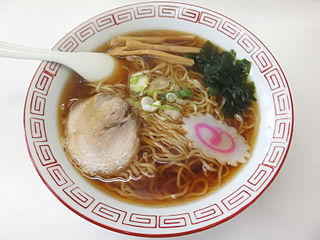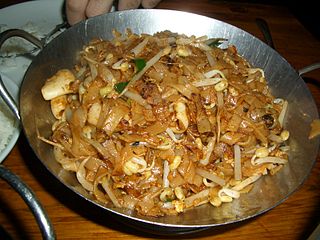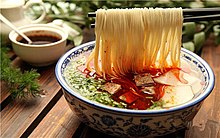
Chinese Islamic cuisine consists of variations of regionally popular foods that are typical of Han Chinese cuisine, in particular to make them halal. Dishes borrow ingredients from Middle Eastern, Turkic, Iranian and South Asian cuisines, notably mutton and spices. Much like other northern Chinese cuisines, Chinese Islamic cuisine uses wheat noodles as the staple, rather than rice. Chinese Islamic dishes include clear-broth beef noodle soup and chuanr.

Ramen is a Japanese noodle dish. It consists of Chinese-style wheat noodles served in a broth; common flavors are soy sauce and miso, with typical toppings including sliced pork, nori, menma, and scallions. Ramen has its roots in Chinese noodle dishes and is a part of Japanese Chinese cuisine. Nearly every region in Japan has its own variation of ramen, such as the tonkotsu ramen of Kyushu and the miso ramen of Hokkaido.

Malaysian cuisine consists of cooking traditions and practices found in Malaysia, and reflects the multi-ethnic makeup of its population. The vast majority of Malaysia's population can roughly be divided among three major ethnic groups: Malays, Chinese and Indians. The remainder consists of the indigenous peoples of Sabah and Sarawak in East Malaysia, the Orang Asli of Peninsular Malaysia, the Peranakan and Eurasian creole communities, as well as a significant number of foreign workers and expatriates.

Chinese noodles vary widely according to the region of production, ingredients, shape or width, and manner of preparation. Noodles were invented in China, and are an essential ingredient and staple in Chinese cuisine. They are an important part of most regional cuisines within China, and other countries with sizable overseas Chinese populations.

Beef noodle soup is a noodle soup made of stewed or braised beef, beef broth, vegetables and noodles. It exists in various forms throughout East and Southeast Asia.

Singaporean cuisine is derived from several ethnic groups in Singapore and has developed through centuries of political, economic, and social changes in the cosmopolitan city-state.

Malaysian Chinese cuisine is derived from the culinary traditions of Chinese Malaysian immigrants and their descendants, who have adapted or modified their culinary traditions under the influence of Malaysian culture as well as immigration patterns of Chinese to Malaysia. Because the vast majority of Chinese Malaysians are descendants of immigrants from southern China, Malaysian Chinese cuisine is predominantly based on an eclectic repertoire of dishes with roots from Fujian, Cantonese, Hakka and Teochew cuisines.

Pancit, also spelled pansít, is a general term referring to various traditional noodle dishes in Filipino cuisine. There are numerous types of pancit, often named based on the noodles used, method of cooking, place of origin, equal and constant diameter or the ingredients. Most pancit dishes are characteristically served with calamansi, which adds a citrusy flavor profile.

Ipoh has a significant food scene with many hawker centres and restaurants. It has dishes derived from Malay, Chinese and Indian cuisine. In recent years, Ipoh has seen an increase in international restaurants, bars and gastropubs which have become popular with locals and tourists.

Noodle soup refers to a variety of soups with noodles and other ingredients served in a light broth. Noodle soup is a common dish across East Asia, Southeast Asia and the Himalayan states of South Asia. Various types of noodles are used, such as rice noodles, wheat noodles and egg noodles.

Chinese Indonesian cuisine is characterized by the mixture of Chinese with local Indonesian style. Chinese Indonesians, mostly descendant of Han ethnic Hokkien and Hakka speakers, brought their legacy of Chinese cuisine, and modified some of the dishes with the addition of Indonesian ingredients, such as kecap manis, palm sugar, peanut sauce, chili, santan and local spices to form a hybrid Chinese-Indonesian cuisine. Some of the dishes and cakes share the same style as in Malaysia and Singapore, known as Nyonya cuisine by the Peranakan.

Lamian is a type of soft wheat flour Chinese noodle that is particularly common in northern China. Lamian is made by twisting, stretching and folding the dough into strands, using the weight of the dough. The length and thickness of the strands depends on the number of times the dough is folded.

Mr. Lee is a popular fast-food chain in mainland China, specializing in beef noodle soup and other Chinese-style fast food. It is headquartered in Beijing. The chain was formerly called California Beef Noodle King U.S.A..

Cart noodle is a noodle dish which became popular in Hong Kong and Macau in the 1950s through independent street vendors operating on roadsides and in public housing estates in low-income districts, using carts. Many street vendors have vanished but the name and style of noodle endures as a cultural icon.

Hui mian is a Henan-style noodle soup. The ingredients used in the dish vary across different cities and restaurants. Typically, hui mian is made with lamb bones and a range of Chinese herbs, such as lycium chinense and star anise. However, kelp, tofu, coriander, quail eggs, chili oil, sugar, garlic, and minced peppers are also common ingredients.

Laghman is a dish of meat, vegetables and pulled noodles from Uyghur cuisine and Central Asian cuisine. In Chinese, the noodle is known as latiaozi or bànmiàn.

Alkaline noodles, alkali noodles, or alkaline pasta is a variation of noodles with a much higher quantity of alkali than usual. The most common examples are Chinese lamian noodles and Japanese ramen noodles. The addition of alkali changes both the flavor and texture of the noodles, and makes them feel slippery in the mouth and on the fingers; they also develop a yellow color and are more elastic than ordinary noodles. Various flours such as ordinary all-purpose white flour, bread flour, and semolina flour can be used, with somewhat varying results. The yellow color is due to flavones that occur naturally in flour, which are normally colorless but turn yellow at alkaline pH.

Indonesian noodles are a significant aspect of Indonesian cuisine which is itself very diverse. Indonesian cuisine recognizes many types of noodles, with each region of the country often developing its own distinct recipes.
Ma Ji Yong is a Chinese chain of Lanzhou beef noodle soup restaurants. It was established in Shanghai in 2019. On 1 May 2021, the company received its first round of private equity investment from HongShan, Challenjers Venture, Gaorong Capital and K2 Venture Partners. As of early 2022, Ma Ji Yong operated 81 locations. On 27 January 2022, the company received investment from Tencent.























